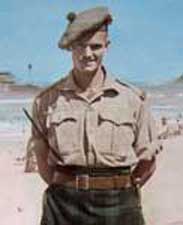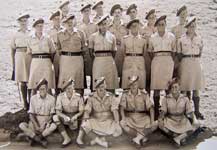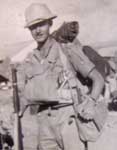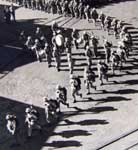Web Equipment, Braithwaite: L/Cpl G.F. Lamont
27479 L/Cpl Gordon Forrester Lamont, 2nd Transvaal Scottish.
 My father was called up into the UDF, under the Active Citizen Force scheme, like most young South African men during the late 1930’s. As this was the depression era, my father like many had been forced to leave school at the minimum school leaving age and help the family income. Living in Johannesburg, he was placed in the Transvaal Scottish (TS), for various 3 month “camps”. Ironically, it was the TS that had been positioned in the garden of the house of my grandfather during the 1922 Miner’s Strike. This strike tested the resolve of the young Union of South Africa Government and saw armoured cars (of which the UDF only had about 3) and aircraft used to put down a large and vicious group of well-armed rebel miners. My grandfather was the Station Master and the family lived in the official house at Jeppe Station, the largest junction in Johannesburg and a key point on the vital rail network. At the age of 5, my father had become the target of a miner’s sniping, while crossing from the house to the outhouse (no indoor plumbing in those days) and had been rescued into a trench, where the platoon of the TS were dug-in in the garden.
My father was called up into the UDF, under the Active Citizen Force scheme, like most young South African men during the late 1930’s. As this was the depression era, my father like many had been forced to leave school at the minimum school leaving age and help the family income. Living in Johannesburg, he was placed in the Transvaal Scottish (TS), for various 3 month “camps”. Ironically, it was the TS that had been positioned in the garden of the house of my grandfather during the 1922 Miner’s Strike. This strike tested the resolve of the young Union of South Africa Government and saw armoured cars (of which the UDF only had about 3) and aircraft used to put down a large and vicious group of well-armed rebel miners. My grandfather was the Station Master and the family lived in the official house at Jeppe Station, the largest junction in Johannesburg and a key point on the vital rail network. At the age of 5, my father had become the target of a miner’s sniping, while crossing from the house to the outhouse (no indoor plumbing in those days) and had been rescued into a trench, where the platoon of the TS were dug-in in the garden.
 Up to WW2, the TS still wore kilts for all purposes, with a Khaki apron in place of a sporran. The equipment was Pattern 1908 left over from WW1 and the rifles were the SMLE (Short Magazine Lee Enfield) .303-in., also from WW1. Training consisted of lots of route marches and field exercises. Marching was the prime means of movement, as the UDF had few lorries and these were also vintage vehicles, with solid rubber tyres, normally used only when more than 25 miles needed to be covered rapidly. Otherwise troop-trains were used for mass movement to the nearest railway station, then a march with the pipe band in front.
Up to WW2, the TS still wore kilts for all purposes, with a Khaki apron in place of a sporran. The equipment was Pattern 1908 left over from WW1 and the rifles were the SMLE (Short Magazine Lee Enfield) .303-in., also from WW1. Training consisted of lots of route marches and field exercises. Marching was the prime means of movement, as the UDF had few lorries and these were also vintage vehicles, with solid rubber tyres, normally used only when more than 25 miles needed to be covered rapidly. Otherwise troop-trains were used for mass movement to the nearest railway station, then a march with the pipe band in front.
My father was selected for further training and under went courses at Robert’s Heights (later Voortrekkerhoogte and now Thaba Tswane) in Pretoria, the main military garrison in South Africa, dating from the Second Anglo-Boer War, 1898 – 1902. Here, he was instructed in the use of troops using rifle, bayonet, hand grenade and armoured vehicles. The latter was mostly theory from WW1 as UDF armour at the time comprised 2, or 3 Crossley armoured cars, 1 Whippet tank, though it was in the process of acquiring a Vickers Medium tank for evaluation. My father was successful and was promoted to Lance Corporal and made a Section Leader.

 With the outbreak of WW2, the TS was mobilized and then divided to form the 1st Battalion TS (1TS) and the nucleus of a new 2nd Battalion (2TS) to which my father was posted. During this time my parents married. The 2TS formed part of the 6th (Police) SA Brigade (with 2 battalions of South Africa Police) in the 2nd SA Division and eventually went “up-north” in 1940, aboard the Troop Ship Mauretania. On arrival in Egypt, the Division had still not been issued with any automatic weapons, other than a “cut-away” Bren for instructional purposes. The first machine guns acquired were captured Italian BREDA and French Hotchkiss, used in the anti-aircraft role protecting the Cairo to Alexandria railway. The first Bren Guns were to follow later.
With the outbreak of WW2, the TS was mobilized and then divided to form the 1st Battalion TS (1TS) and the nucleus of a new 2nd Battalion (2TS) to which my father was posted. During this time my parents married. The 2TS formed part of the 6th (Police) SA Brigade (with 2 battalions of South Africa Police) in the 2nd SA Division and eventually went “up-north” in 1940, aboard the Troop Ship Mauretania. On arrival in Egypt, the Division had still not been issued with any automatic weapons, other than a “cut-away” Bren for instructional purposes. The first machine guns acquired were captured Italian BREDA and French Hotchkiss, used in the anti-aircraft role protecting the Cairo to Alexandria railway. The first Bren Guns were to follow later.
Thereafter, the 2 SA Div went into the desert and the struggle for control of that vast desolate area. My father was wounded in the shoulder, during a night reconnaissance, at a place called 3 Wells. That night he was carrying one of the few Thompson sub-machine carbines issued to the battalion, which he used to deadly effect. Following convalescence, he wangled his way back to the 2TS (instead of going into the pool of replacement troops), only to be captured in the disastrous loss of Tobruk.
 My father found life as a PoW very tough. He stated that they only survived because of the neglect and their own determination and the Red Cross. Following capture, his whereabouts were not known and he was posted “missing” for 3 years. Once captured by the Germans, at Tobruk, they were handed to the Italians. My father and his colleagues had not viewed the Italians as the enemy, more as a joke. However, in Italian hands, they suffered extreme neglect. They were herded into the desert, miles from anywhere, inside a poor barbed wire corral. If they tried to escape, they were shot and left. They were not given food, or water and there were no facilities of any kind. Very soon, thousands were dying of dysentery. Some weeks later they were herded onto ships, into the holds with only one hatch-board left open and a single straight ladder to the deck. Access to the deck, where the few primitive heads (toilets) were, was limited; the filth and smell with all the (surviving) dysentery cases cannot be imagined. The only highlight was when the Italians, in a rare moment of efficiency, shot down an aircraft - a German aircraft sent to escort them! In Italy they were once again very neglected and only survived on limited Red Cross aid and what they were able to barter on the black-market. Salvation was when they were sent out to work on farms and were fed by the farmers. While on the run for the second time, the son of an Italian family, that was sheltering my father and some of his section, was tortured to death by the Germans, in an un-successful effort to find the escapees. I still have a copy of the son’s last letter to his family and a translation, which was received by my father after the war, where he mentions my father “the professor”. Despite his low opinion of the Italian military, he had great respect for the Italian civilians, who had sheltered him and the rest of his section. After being captured again, they ended up in German hands.
My father found life as a PoW very tough. He stated that they only survived because of the neglect and their own determination and the Red Cross. Following capture, his whereabouts were not known and he was posted “missing” for 3 years. Once captured by the Germans, at Tobruk, they were handed to the Italians. My father and his colleagues had not viewed the Italians as the enemy, more as a joke. However, in Italian hands, they suffered extreme neglect. They were herded into the desert, miles from anywhere, inside a poor barbed wire corral. If they tried to escape, they were shot and left. They were not given food, or water and there were no facilities of any kind. Very soon, thousands were dying of dysentery. Some weeks later they were herded onto ships, into the holds with only one hatch-board left open and a single straight ladder to the deck. Access to the deck, where the few primitive heads (toilets) were, was limited; the filth and smell with all the (surviving) dysentery cases cannot be imagined. The only highlight was when the Italians, in a rare moment of efficiency, shot down an aircraft - a German aircraft sent to escort them! In Italy they were once again very neglected and only survived on limited Red Cross aid and what they were able to barter on the black-market. Salvation was when they were sent out to work on farms and were fed by the farmers. While on the run for the second time, the son of an Italian family, that was sheltering my father and some of his section, was tortured to death by the Germans, in an un-successful effort to find the escapees. I still have a copy of the son’s last letter to his family and a translation, which was received by my father after the war, where he mentions my father “the professor”. Despite his low opinion of the Italian military, he had great respect for the Italian civilians, who had sheltered him and the rest of his section. After being captured again, they ended up in German hands.
 My father became prisoner No 131434 in Stalag Vll/A, north of Moosberg, in Germany (I still have this dog-tag along with his UDF dog-tags). On one occasion, the Germans took a dislike to a church service one Sunday, so the Church-parade was machine-gunned! Once again food was absolutely minimal, usually a bowl of cabbage-water “soup” per day, this while doing slave-labour like laying railway track to repair damage from air raids. Replacement clothing was not provided and their kit was reduced to rags, with straw tied around their feet in winter. Again he was adamant they would never have survived without Red Cross help. During this time they were bombed by the Allies, who did not know that there were PoWs in the rail yards. Towards the end, Dad was sent on the forced-marches to Poland, supposedly to work in the coal-mines. He managed to avoid going to the mines, but while on the marches the food came from foraging in the fields. Being wise in the way of life my father claimed to be a butcher, when one day a dead horse had been found and he got the nose for himself and the remaining members of his Section!
My father became prisoner No 131434 in Stalag Vll/A, north of Moosberg, in Germany (I still have this dog-tag along with his UDF dog-tags). On one occasion, the Germans took a dislike to a church service one Sunday, so the Church-parade was machine-gunned! Once again food was absolutely minimal, usually a bowl of cabbage-water “soup” per day, this while doing slave-labour like laying railway track to repair damage from air raids. Replacement clothing was not provided and their kit was reduced to rags, with straw tied around their feet in winter. Again he was adamant they would never have survived without Red Cross help. During this time they were bombed by the Allies, who did not know that there were PoWs in the rail yards. Towards the end, Dad was sent on the forced-marches to Poland, supposedly to work in the coal-mines. He managed to avoid going to the mines, but while on the marches the food came from foraging in the fields. Being wise in the way of life my father claimed to be a butcher, when one day a dead horse had been found and he got the nose for himself and the remaining members of his Section!
The biggest risk on the marches was once again dysentery and also being crushed, by tanks being driven to the advancing Russian Army by un-trained drivers. If the PoWs tried to move out of the way from the tanks, or because of the “runs” from dysentery, they were shot. Whilst on one of the forced marches, in Poland, they were liberated by the Russians, who put their own troops on further reduced rations, in order to feed the former prisoners. From there, they were passed to the Americans and on to the British, who flew them to the UK and South African control in Brighton. He then weighed under 100 pounds! The war was not over in Europe, but they were apparently given a “pass”, which allowed them un-limited access to food. The only restriction was that it had to be consumed on the premises (restaurant, or shop) and not be taken away. The sheet, D.D. 409 S.A., was issued when my dad was partly re-kitted in South Africa, after repatriation from the UK. This was the first stage of him being sent to the Far East. He wanted to get some action in after all he had missed as a PoW.
My earliest recollection of my Dad was him as a very skeletal figure, given 6 months to live in about 1950. He lasted to 1975 by sheer determination, but with pain from his shoulder wound (rifle bullet) and damaged lungs. I still have his Active Service Testament that he carried throughout the War. This was one of the items of his that started me on becoming a collector of militaria, from about the age of 8.
John Lamont
January, 2010